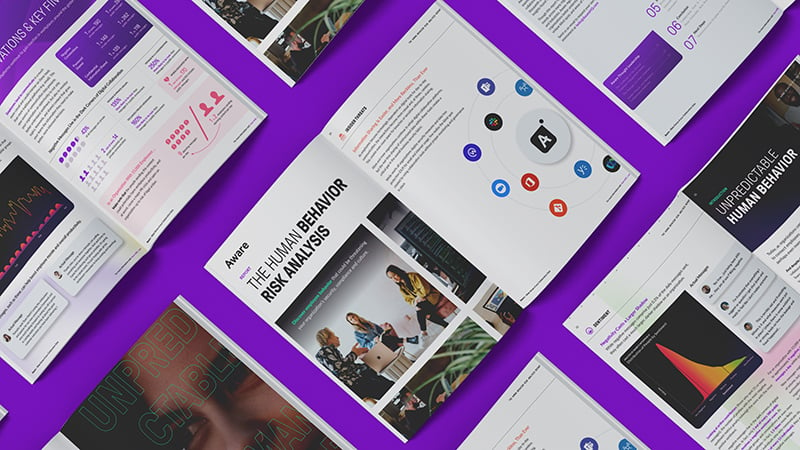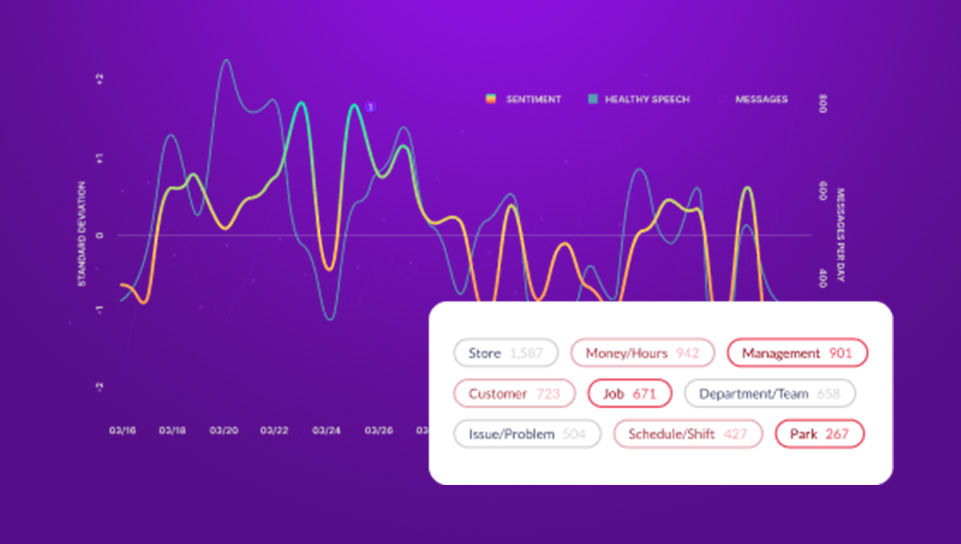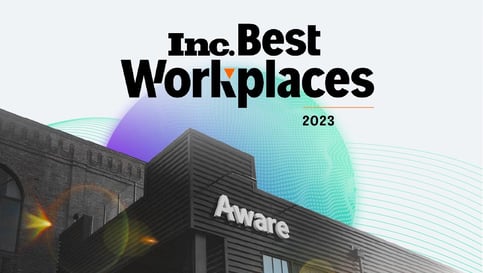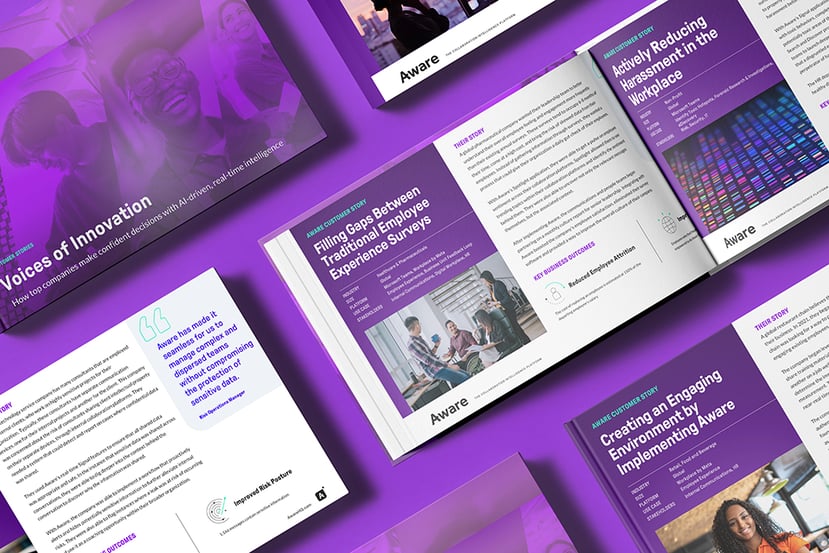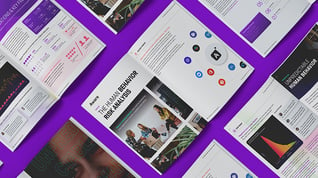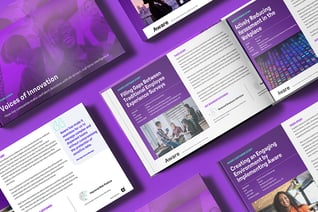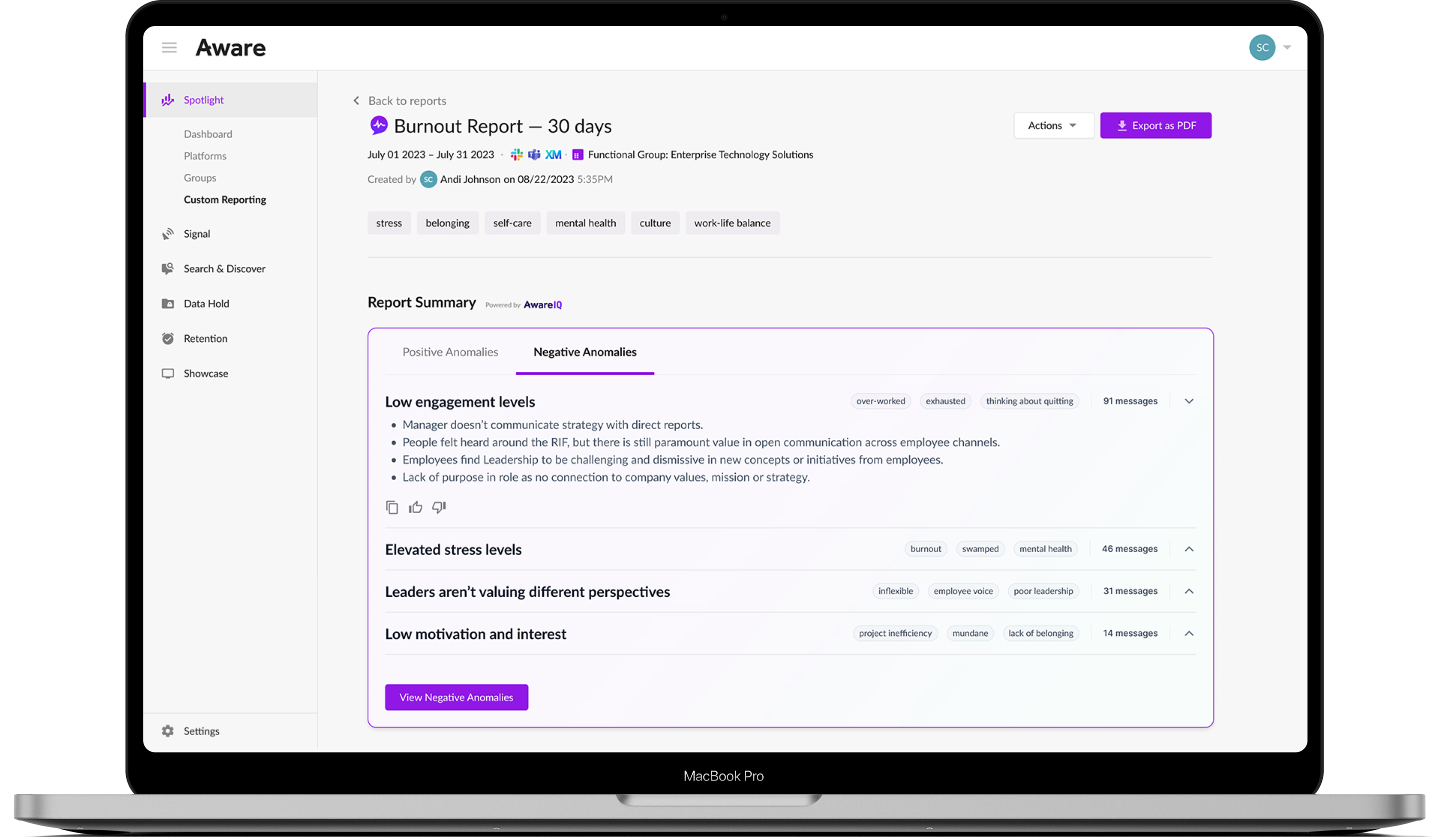How AI is Disrupting Employee Engagement Surveys
by Aware
AI is transforming the workplace engagement survey. Today’s innovative leaders are using smart technology to unlock real-time actionable insights through smart analysis and continuous listening.
Employee engagement surveys are a critical component of employee listening strategies, but they are fraught with complexities that make them problematic as sources of information. While annual polling might be useful for generating a regular benchmark to measure employee performance and sentiment, it doesn’t address the most pressing issues affecting the workforce in real time. In the six months or more between initiating an employee engagement survey and getting the results, anything could have happened. A round of layoffs. A bad news story about the CEO. A global pandemic.
Businesses have long recognized this oversight. Even workplace survey giant Qualtrics admits that “Surveys don't often happen enough.” For many years, the solution has been more surveys. And while smaller, more frequent pulse surveys can provide meaningful analysis between annual engagement surveys, they still fall short of producing the authentic, real-time insights that employers want. As survey provider Perceptyx acknowledges, “There are many nuances that you simply can’t get at with questions on a survey.”
Top 10 problems with employee engagement surveys
- They happen too infrequently to provide meaningful sentiment insights.
- Slow execution can make survey results obsolete before they’re delivered.
- The act of choosing what to ask and what to omit introduces inescapable bias.
- Unclear questions or answers can create confusion and disrupt survey results.
- Lack of trust between employees and leaders produces false answers about difficult subjects.
- Disengaged employees are unlikely to respond, omitting the most critical voices.
- Survey fatigue demotivates employees, reducing the number of thoughtful responses.
- Analysis of long-form survey responses is usually done manually, over-relying on “gut feeling.”
- They amplify the loudest voices and strongest opinions, not the silent majority.
- Failing to respond quickly creates the perception that leadership ignores employee opinions.
The challenge of analyzing survey results
In addition to the complexities of administering employee engagement surveys, there is also the challenge of making sense of the results. Ambiguous questions and low response rates can both distort quantitative data, misleading executives and causing critical business decisions to be based on faulty information.
One of the most valuable sources of unfiltered employee feedback is the long-form answers provided during annual or pulse surveys. However, in large organizations the sheer volume of responses can make it difficult to extract trends and insights. Often this work is performed manually, takes considerable time to complete, and over-relies on “gut feeling” or unconscious bias.
The solution to continuous people intelligence
It’s clear that surveys aren’t a good vehicle for accessing authentic, honest feedback on a continuous basis. However, while imperfect, they have historically been the best tool for the job. But the digital transformation has revolutionized the modern workplace and introduced a new source of data. One where employees are talking at volume every single day.
Workplace collaboration tools like Slack, Teams, and Zoom have enjoyed huge success since the outset of the pandemic. A massive 280 million people use Teams at work, and the average Slack user sends 23 messages per day. Over a year, just 5000 employees will generate 30 million collaboration messages. That’s more data than any workplace engagement survey can produce.
What does that dataset contain? A wealth of insights about how your business runs — everything from feedback on operational processes to customer comments and insights into how the company can become a better version of itself. Is a mechanical breakdown or supplier failure a one-off incident or part of a wider systemic problem? How are customers responding to new (or discontinued) products and services? What red tape creates more problems for your people than it solves? Collaboration data can answer those questions and more.
5 reasons to augment engagement surveys with collaboration data insights
- Collaboration messages provide data from across the enterprise. All employees, engaged and disengaged, junior and senior, use collaboration tools, giving you an authentic overview of the organization as a whole.
- There’s no need to disrupt the workplace to get data. One of the challenges of surveys is getting people to engage with a new tool or website to provide feedback. Workplace insights from collaboration come from tools already in use.
- Overcome question bias by analyzing collaboration. By listening continuously, businesses gain an organic understanding of the topics that matter most to employees, without having to ask the question.
- Employers get real-time results and insights. Collaboration happens every day, providing a rich source of real-time insights into how the business is operating and what changes are top-of-mind.
- Continuous listening supports strategic leadership. Passive listening removes the urgency to respond, enabling more deliberate, strategic leadership that makes employees feel heard.
AI is unlocking the insights hidden within survey and collaboration datasets
Like long-form survey responses, collaboration data is incredibly powerful, but also incredibly complex. To get actionable insights from these human voices at scale, businesses need the power of artificial intelligence. Only a computer can ingest millions of real-time messages and extract trends and insights from them as they emerge.
AI workplace survey and collaboration insights from Aware are accelerating and simplifying the work of HR and People leaders by analyzing survey responses to surface exactly what employees are trying to say and augmenting those findings with a continuous visualization of real-time fluctuations in collaboration sentiment. Collectively, these insights help leaders to identify the emerging topics impacting the highest number of people within the organization. They’re the insights you always wished you could get, delivered every day, without disrupting your workforce.
What can businesses do with AI-driven workplace insights from Aware?
Using insights from survey feedback and collaboration data, infused with AI analysis from Aware, organizations can identify risks and solve problems across the whole organization from a single, centralized dashboard.
- Proactively address security risks such as insider threats and data exfiltration
- Enforce and maintain compliance with regulatory and internal policies
- Identify areas where operational inefficiencies are creating frustrations
- Enhance the employee experience and address toxicity before it spreads
Aware’s AI data platform was built and trained exclusively on billions of real conversational messages. It understands the complexities of natural language datasets in ways that legacy employee listening tools don’t. That’s why Aware is the industry leader for providing real-time sentiment analysis and people intelligence across all major survey and collaboration tools. We help the world’s most innovative companies to extract actionable, authentic insights from employee voices at scale.
